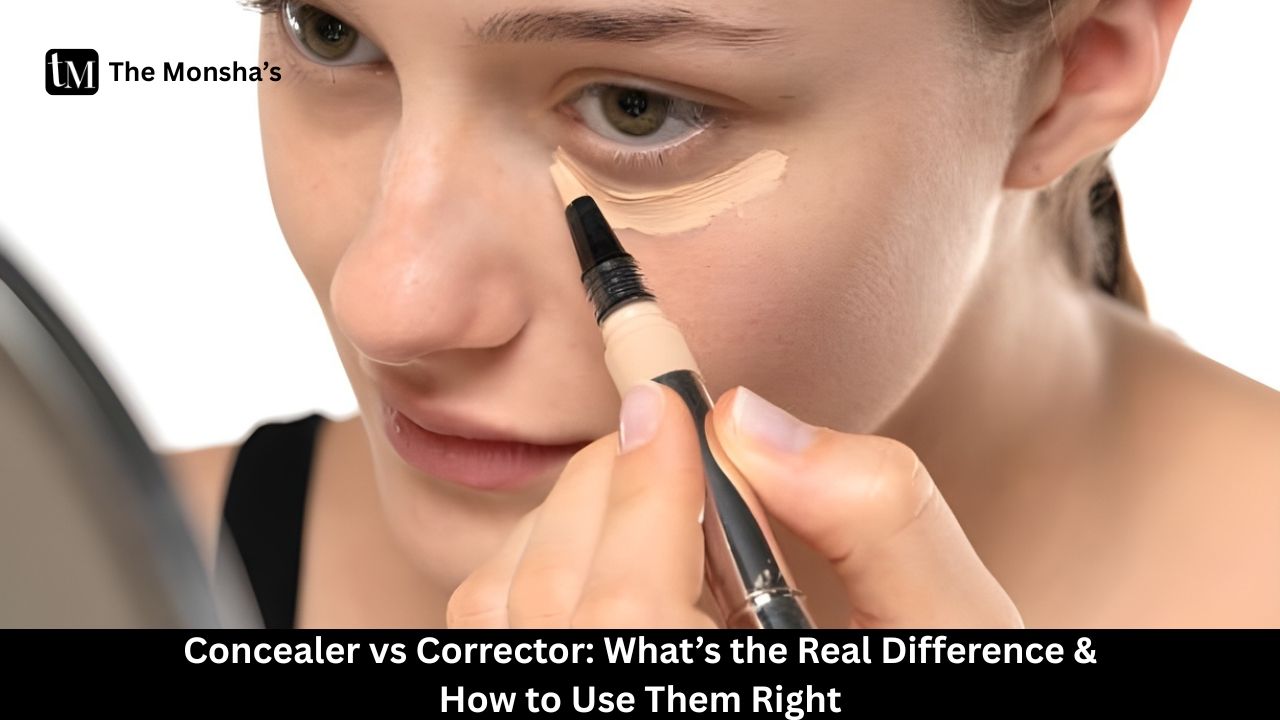TL;DR
Concealer = cover and blend. Corrector = neutralize discoloration. Concealers come in skin-tone shades to hide blemishes, spots, and under-eye shadows. Correctors come in color-theory hues (green, peach, lavender) to cancel out specific undertones before concealer. For mild imperfections, concealer alone works. For stubborn dark circles or redness, corrector + concealer = unbeatable. “Samajh lo, concealer mask hai aur corrector magic trick.” 😉
Introduction – The Makeup Drawer Confusion 😅
Ever stared at your makeup bag, holding both a concealer and a mysterious peach or green stick, and thought—“bhai, yeh dono alag kaise hain?” You’re not alone. I remember layering concealer over my dark circles, only to look like a tired raccoon with beige halos. Enter: corrector. These two are cousins, not twins, and understanding their roles will literally save your face (and your selfies).
What Is Concealer? 🪄
- A skin-toned product designed to cover blemishes, scars, redness, or under-eye darkness.
- Comes in liquid, cream, stick, or powder.
- Works by matching your skin tone and blending into foundation.
- Best for: pimple marks, uneven skin patches, or quick brightening under the eyes.
Think of concealer as your camouflage tool—it hides but doesn’t fix underlying color issues.
What Is a Corrector? 🌈
- A tinted product based on color theory.
- Neutralizes discoloration before concealer.
- Common colors:
- Peach/Orange: Cancels blue/purple under-eye circles.
- Green: Cancels redness from acne or rosacea.
- Lavender: Brightens dull, sallow skin.
- Texture is usually lightweight cream/liquid for layering.
Corrector is like the primer for your concealer—without it, concealer may look ashy or grey.
Concealer vs Corrector – Key Differences 📊

👉 Translation: Concealer hides, corrector solves. Ek ne mask pehna diya, doosre ne problem hi khatam kar di.
When & Why to Use Which 🎯
Mild Issues
- Use concealer alone.
- Example: small blemishes, slight redness.
Dark Under-Eye Circles
- Corrector (peach/orange) first, then concealer.
- Example: blue-tinged hollows.
Redness / Pimples
- Green corrector + concealer.
- Example: inflamed acne, rosacea patches.
Dullness or Yellow Tone
- Lavender corrector + concealer.
- Example: sallow complexion, uneven tone.
“Glossy magazines mein flawless skin dikhti hai, par asli flawless toh sahi corrector + concealer combo se hi banti hai.” 💁♀️
How to Apply Them Properly 👇
Step 1 – Prep
- Cleanse, moisturize, and use primer.
- For under-eyes, tap a hydrating gel or cream.
Step 2 – Apply Corrector
- Use sparingly on the discolored zone only.
- Blend gently with brush, sponge, or fingertip.
Step 3 – Layer Concealer
- Dab skin-tone concealer on top.
- Blend outward, thin layers only.
Step 4 – Set
- Use setting powder or spray to lock it in.
Tips & Pro Hacks 💡
- Less is more: Too much corrector = clown vibes.
- Warm it up: Use fingertip heat for smoother blend.
- Choose wisely: Lighter concealer for under-eyes, exact match for spots.
- Micro-layer: Thin layers blend better than one thick swipe.
- Check in daylight: What looks fine indoors may look patchy outside.
Common Mistakes to Avoid ❌
- Using concealer without corrector on very dark circles → looks grey.
- Applying corrector after concealer (wrong order).
- Overapplying both products → cakey finish.
- Choosing wrong shades (green on dark circles = disaster).
Real Results You Can Expect ⏱️
- With concealer only: decent coverage, but stubborn discoloration may peek through.
- With corrector + concealer: even tone, bright under-eyes, smoother finish.
- Longevity: Corrector helps concealer last longer without creasing.
I once did a wedding look with concealer alone—two hours in, the bride’s under-eyes looked grey. Redid with peach corrector + concealer, and suddenly—no trace of exhaustion.
Conclusion – Which One Do You Really Need? 💖
Both. If imperfections are light, stick to concealer. But if you’re battling bluish under-eyes or fiery red pimples, corrector is your silent hero. The dream team is corrector to fix + concealer to blend.
Cheat mantra: “Concealer hides, corrector heals the illusion. Saath mein use karo, aur skin bole—thank you!” 😌
FAQs 🙋♀️
Q1: Can I skip corrector?
Yes, for mild issues. But for strong discoloration, it’s essential.
Q2: Which corrector shade for Indian skin?
Peach/orange for dark circles, green for redness.
Q3: Can I use corrector alone?
No, it needs concealer on top to look natural.
Q4: Will it look cakey if I use both?
Not if applied in thin, blended layers.
Q5: Which goes first—concealer or corrector?
Corrector always comes first.
Q6: Do I need both for daily makeup?
Not always—depends on skin concerns and time.

